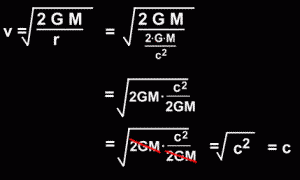|
Page 2 Let's examine a 10 solar mass black hole close up. This remnant was once a giant star billions of miles in diameter; all that remains is the star's super-dense core, which has been compressed to a tiny sphere whose 'event horizon' is a mere 50 kilometres wide. This core still has the mass of a sun, and the gravitational pull to match. Anything that gets pulled inside the event horizon can never escape, since the gravitational pull is so enormous, not even light (which has no mass at all and moves faster than anything else) can't escape. 
We would not see the black hole if we could look at it from a distance, since any light hitting it can't bounce back to our eyes. But we can see where the object must be, because it bends the path of light rays passing close. Light from the stars in the distance, behind the black hole, gets pulled towards it, as it passes. This has the effect of making the light from behind the black hole bend around it, producing a ring of stars surrounding a black void. You see the stars that are behind the black hole! It's sort of like the way a water drop magnifies light, except in reverse. If you get too close to the black hole, within a few tens of thousands of kilometres, you will begin to experience tidal forces on your body. The gravity increases so quickly with distance at this point that the pull is noticeably stronger on the end of your body that is closer to the black hole. If you get within 8000 kilometres, the difference in forces between the two ends of your body is about four times your weight. Get much closer, and these differing forces will pull your body apart! Strangely enough, smaller black holes have a much stronger tidal force. You can get closer before the effects are noticeable, but when they do start to build up, they increase much faster.  Mathematically, this can be explained the following way. The tidal force is proportional to the mass of the black hole. In other words, as the object gets less massive, the force should get smaller too. But the force is also inversely proportional to the cube of the object's radius. As the hole gets smaller in size, because of the cube factor on the radius, the force, increases much faster than any possible mass decrease can account for. So big black holes have weak tidal forces, and small ones have strong tidal forces. Mathematically, this can be explained the following way. The tidal force is proportional to the mass of the black hole. In other words, as the object gets less massive, the force should get smaller too. But the force is also inversely proportional to the cube of the object's radius. As the hole gets smaller in size, because of the cube factor on the radius, the force, increases much faster than any possible mass decrease can account for. So big black holes have weak tidal forces, and small ones have strong tidal forces.We should mention that these are tidal forces we are talking about. They're the forces that will pull your body apart as it approaches the black hole, because gravity is stronger on the end of your body that's closer to the hole. The simple force of gravity that is pulling you towards the event horizon increases directly as the mass of the hole, so big black holes can reach out farther and grab you. The difference is that with a big black hole, you'll get much closer to the surface before you get pulled apart! Now let's imagine you allow the gravity of a black hole to pull you towards it. We'll ignore tidal forces, and explore what will happen. We need to refer to Einstein's description of the effects of gravity, because the force on you is now enormous. Einstein described gravity as a 'distortion of space and time' caused by large masses. Your space and time is about to be distorted, just as if you were moving at a speed close to the speed of light. (In fact, you will be moving almost that fast as you reach the black hole). What happens can be predicted using Einstein's general relativity equations ... you begin to elongate in the direction you are moving, your mass begins to increase very quickly, and time begins to run slower. All this could be observed by someone watching you fall towards the black hole; from your viewpoint, you will feel normal, but the rest of the universe will seem to be behaving oddly. From your viewpoint, once you have passes the event horizon, you can't get back out. Nothing can, not even light.You will be compressed out of existance. What's inside a black hole is unknown (it's called a 'singularity'), but we know that you will have ceased to exist by this point. Now let's examine the event horizon of a black hole more closely. The event horizon (beyond which nothing can come back) is also called the Schwarzschild radius. This radius can be described mathematically:  We can also examine the speed you would need, to escape from the clutches of a black hole. If we use the familiar escape velocity formula (Physics 20):   How can we possibly see star-sized black holes from distances of many thousands of light years? The answer is simple ... we can't. But we can easily see the results of a black hole's presence. For example, when a black hole sucks in material in vast quantities, that material emits x-rays and other radiation as it accelerates towards the hole. Stars often occur in pairs, called 'binaries'. (Our sun was almost a pair of stars, if Jupiter hadn't been a little too small to have the pressure needed to turn on fusion). If we observe a pair of stellar masses orbiting one another, with x-rays being emitted from near one of them as material from the other is being sucked into it, but we can't see that second star, we can assume it is a star-black hole combination.  Similarly, black holes can be indirectly observed at the centre of exploded supernovae. This was how the first black hole was detected, by astronomers at the University of Toronto, in the early 1970's. Side Note: one of the scienists involved in that discovery was my Astronomy professor in 2nd year! It has been shown theoretically by Stephen Hawking that when 'virtual particles' (undetectable quantum particles that carry gravity and light) enter the event horizon and get sucked into the singularity, they use up more energy than they have, and so contribute 'negative energy' to the black hole. As a result, the mass of the singularity decreases ... and the black hole can eventually 'evaporate'. So black holes can get smaller, and eventually disappear. But only tiny ones ... big ones will survive billions of years. What are 'virtual particles'? Fluctuations of the gravitational field near superstrong gravity sources can create pairs of virtual particles (a particle and its antiparticle). Ordinarily, they will move apart slightly, then back together to annihilate each other, very quickly. However, if the pair is created right at the event horizon of a black hole, as they move slightly apart one can become trapped inside the event horizon and one left outside it. They can't then get back together to annihilate. The result? Without its virtual partner, the escaping particle becomes a real particle, and appears to us on Earth watching it happen to be radiation coming 'from the black hole'. This is called Hawking Radiation, and actually radiates from just outside the event horizon. Finally, we need to mention the other kind of black hole. (Remember? We said there were two kinds). The second type is enormous, and can be found at the centre of many galaxies, perhaps even our own. Billions of suns in the dense centre of a galaxy become supernovas all at once, and the entire galactic core becomes one huge black hole. The stupendous amount of radiation released from such occurrences is thought to be responsible for quasars. We'll save that for another page! |